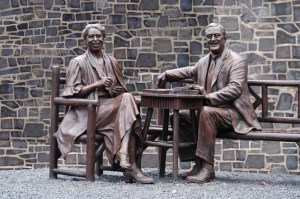 I’ll tell you a little secret. My wife and I were going to go to live theater this month. The Barrington Theatre’s main stage was to host Mark St. Germain’s play Eleanor. It would star Tony award-winning performer Harriet Harris. “The play, directed by Henry Stram, brings to life Eleanor Roosevelt, one of the most influential first ladies in American History. The play has two shows, September 4 and 5.”
I’ll tell you a little secret. My wife and I were going to go to live theater this month. The Barrington Theatre’s main stage was to host Mark St. Germain’s play Eleanor. It would star Tony award-winning performer Harriet Harris. “The play, directed by Henry Stram, brings to life Eleanor Roosevelt, one of the most influential first ladies in American History. The play has two shows, September 4 and 5.”
We had gone to the Pittsfield, MA venue a few times in the past two years. The theatre would have had limited, socially distanced seating and a cast of one. It seemed that the proper protocols were in place. We bought our tickets. Then the live production of the one-act play was shut down by new decisions from the state of Massachusetts.
My wife got a call perhaps a month ago. Our choices were several. We could get a refund, accept credit for future productions, or donate the value of the tickets. But there was a fourth option. Eleanor would now be streamed for two nights. “The play [was] filmed without an audience… In-person ticket holders will automatically be sent a link to the 7:30 show; others interested in watching the performance can purchase tickets now for $15.”
The play’s the thing
“Eleanor brings to life Eleanor Roosevelt, the most influential First Lady the world has ever seen. From her ‘Ugly Duckling’ upbringing to her unorthodox marriage to Franklin, Eleanor puts her controversial life, loves and passions on the stage.” The play was written by Mark St. Germain, as a developmental piece, i.e., a work in progress.
We know quite a bit about the former First Lady from multiple trips to Hyde Park, going back to our respective childhoods, and our sojourn to her cottage at Val-Kill. She was the first Very Important Person to die in my recollection.
St. Germain captured Eleanor quite well, from the familiar – FDR’s ongoing relationship with Lucy Mercer – to representations of her presumed inner thoughts. It was interesting in that it is “modern-day,” almost certainly in the last four years. Yet she knows she’s been dead since 1962. The play was directed by Henry Stram, though there was very little action.
All the world’s a stage
Most of the action came from the facial expressions and voices of Broadway performer Harriet Harris. She won the 2002 Tony winner as the Best Featured Actress In A Musical, Thoroughly Modern Millie. She is very good in the role of Eleanor.
This was a reading. In the introduction, it was noted how previous workshopping had cut about 40 minutes from the piece. But Harris had learned much of the dialogue. The frequency of her reading suggests that the tweaks were greater in the earlier parts of the play.
The downsides of this production are the obvious ones. You don’t see the performer’s whole body. Did the audience laugh at that line, as we did? And staring at a screen for 95 minutes is just NOT exactly the theater experience we were hoping for. It was nevertheless a nice date night event, even if it was traveling to my wife’s office rather than driving to the Berkshires.






